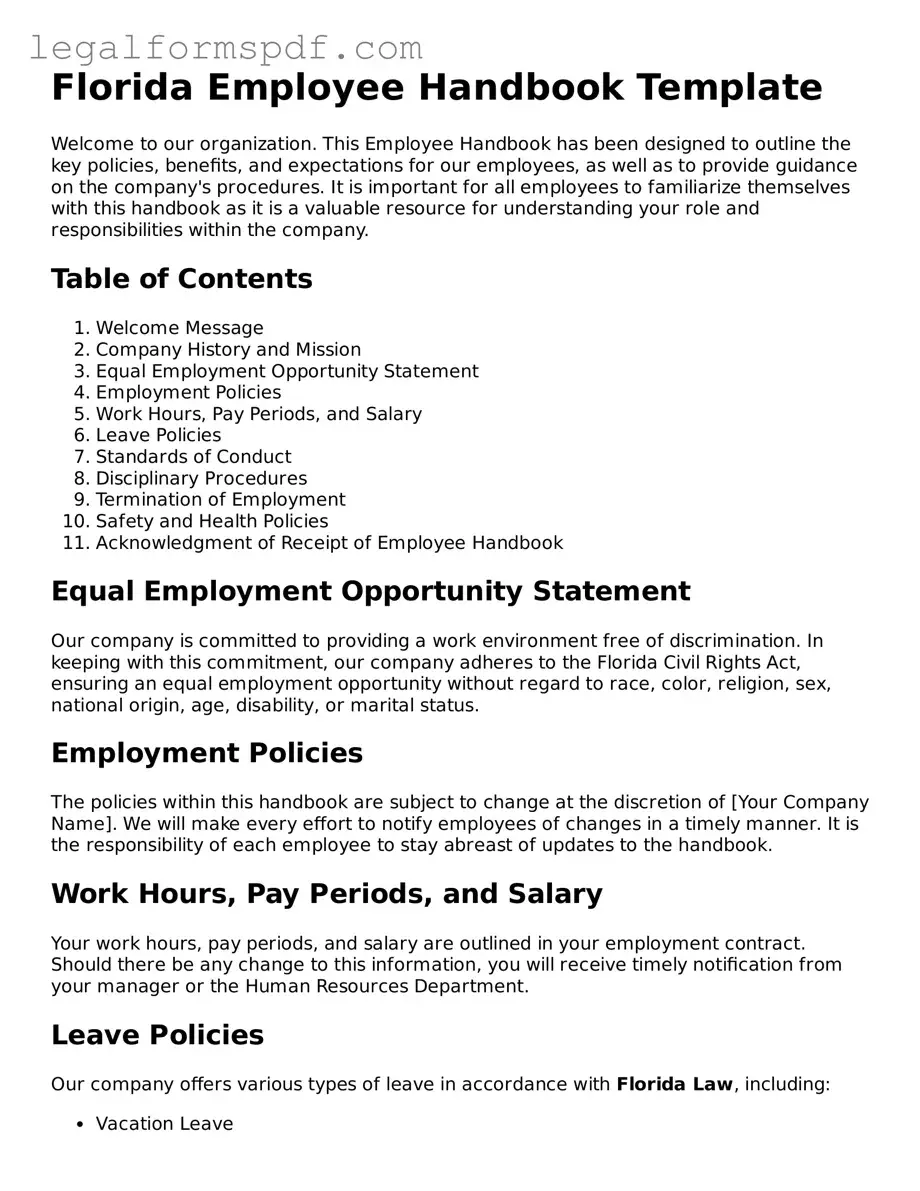Florida Employee Handbook Template
Welcome to our organization. This Employee Handbook has been designed to outline the key policies, benefits, and expectations for our employees, as well as to provide guidance on the company's procedures. It is important for all employees to familiarize themselves with this handbook as it is a valuable resource for understanding your role and responsibilities within the company.
Table of Contents
- Welcome Message
- Company History and Mission
- Equal Employment Opportunity Statement
- Employment Policies
- Work Hours, Pay Periods, and Salary
- Leave Policies
- Standards of Conduct
- Disciplinary Procedures
- Termination of Employment
- Safety and Health Policies
- Acknowledgment of Receipt of Employee Handbook
Equal Employment Opportunity Statement
Our company is committed to providing a work environment free of discrimination. In keeping with this commitment, our company adheres to the Florida Civil Rights Act, ensuring an equal employment opportunity without regard to race, color, religion, sex, national origin, age, disability, or marital status.
Employment Policies
The policies within this handbook are subject to change at the discretion of [Your Company Name]. We will make every effort to notify employees of changes in a timely manner. It is the responsibility of each employee to stay abreast of updates to the handbook.
Work Hours, Pay Periods, and Salary
Your work hours, pay periods, and salary are outlined in your employment contract. Should there be any change to this information, you will receive timely notification from your manager or the Human Resources Department.
Leave Policies
Our company offers various types of leave in accordance with Florida Law, including:
- Vacation Leave
- Sick Leave
- Personal Leave
- Jury Duty Leave
- Bereavement Leave
Details on the eligibility and process for requesting leave can be found in the specific sections of this handbook pertaining to each type of leave.
Standards of Conduct
Our company expects all employees to conduct themselves in a professional and ethical manner at all times. This includes adhering to our company's policies, respecting confidentiality agreements, and avoiding conflicts of interest.
Disciplinary Procedures
Failure to adhere to the policies outlined in this handbook may result in disciplinary action, up to and including termination of employment. Specific disciplinary procedures will be followed in accordance with the seriousness of the offense and may involve verbal warnings, written warnings, suspension, or termination.
Termination of Employment
Termination of employment within our company can occur for various reasons, including but not limited to, redundancy, resignation, or dismissal for cause. Employees will be provided with notice as required under Florida Law.
Safety and Health Policies
Ensuring a safe and healthy work environment is of paramount importance. Our company complies with all applicable health and safety laws, including the Florida Workers' Compensation Law, to provide a safe workplace for all employees. It is the responsibility of each employee to follow safety guidelines and report any unsafe conditions or accidents.
Acknowledgment of Receipt of Employee Handbook
All employees are required to sign an acknowledgment form indicating that they have received, read, and understand the contents of this Employee Handbook. This acknowledgment will be kept in your personnel file.
